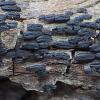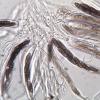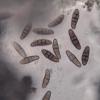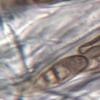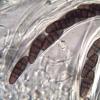
23-06-2025 04:03
 Francois Guay
Francois Guay
Hi, I found this tiny sulfur yellow asco growing o

22-06-2025 13:52
 DirkW
DirkW
Dear friends,anyone out there with this paper?:DOU

26-05-2025 18:09
Henk RemijnGood day,In a burned forest near Hulst on the bord

20-06-2025 08:33
Hello.Small, blackish, mucronated surface grains s

19-06-2025 22:19
Björn NordénBig thanks in advance.

11-06-2025 16:26
Hi everyone, I am looking for the following protol

18-06-2025 19:24
 Bernard Declercq
Bernard Declercq
Good evening,On Oenanthe aquatica we collected a

18-06-2025 16:24
 Andgelo Mombert
Andgelo Mombert
Bonjour,Un minuscule stade imparfait, qui pousse s
Hysterobrevium mori (?) on Juniperus
Lepista Zacarias,
23-05-2016 17:13
I found this lirellate fungus on the roots of a Juniperus shrub. Some of its micro features are:
Asci: cylindrical with up to 110 µm in lenght and ~12 µm in width;
Spores:
- hyaline at first, soon pale brown and later brown;
- 3 to 6 transversal septa and 1 longitudinal septa in one or several middle cells;
- dimensions:
(14) 20 - 23.7 (27.5) × (6.1) 6.3 - 7.4 (7.6) µm
Q = (1.9) 2.9 - 3.5 (3.7) ; N = 31
Me = 22 × 6.8 µm ; Qe = 3.2
Initially I thought that it could be Hysterium, but the spores are more tranversely septate and, moreover, also have a longitudinal septum.
Looking to the information avalable at
http://www.eboehm.com/hysteriaceae.html
I realise that most probably it is a Hysterobrevium sp.. There are only three species mentioned in this genus: H. constrictum, H. mori and H. smilacis, the first and the third with hyaline spores at maturity, leaving Hysterobrevium mori as the possible candidate for the classification. Is it so or are there other choices?
(at the "Key to the species of Hysterographium, Hysterobrevium and Gloniopsis" two other genera are considered but with different features, as far as I can understand. Recently I found a species of Hysterographium but never found one of Gloniopsis.)
I would like to have comments or remarks about this uncommon (for me) find. I attach a set of photos.
Thanks in advance,
zaca
Hans-Otto Baral,
23-05-2016 18:02

Re : Hysterobrevium mori (?) on Juniperus
In my samples of H. mori (all on angiosperms) the spores showed a similar length but were consistently much wider, varying in the range of 7.5-9 up to 10-12 µm and more. But I do not know what is normal in this species.
Lepista Zacarias,
23-05-2016 18:51
Re : Hysterobrevium mori (?) on Juniperus
Thanks, Zotto, for your comment.
In the site mentioned in my message the dimensions for the spores of Hysterobrevium mori are
(12-)14-22(-26) x (5-)7-10(-11) ?m.
Thus they seem to be variable in width and the dimensions I got are within.
In relation to your comment about the host, I found these and the Patellaria atrata in some more or less buried wood recently lifted by some storm. I presumed that it belongs to the only shrubs (Juniperus) actually existing here, but it can be of an ancient tree/shrub.
Regards,
zaca
In the site mentioned in my message the dimensions for the spores of Hysterobrevium mori are
(12-)14-22(-26) x (5-)7-10(-11) ?m.
Thus they seem to be variable in width and the dimensions I got are within.
In relation to your comment about the host, I found these and the Patellaria atrata in some more or less buried wood recently lifted by some storm. I presumed that it belongs to the only shrubs (Juniperus) actually existing here, but it can be of an ancient tree/shrub.
Regards,
zaca
Hans-Otto Baral,
23-05-2016 21:46

Re : Hysterobrevium mori (?) on Juniperus
Coniferous wood is easily distinguished from angiosperm wood when looking with a strong handlens on the pores.
I wonder about such strong variation in spore l:w ratio. maybe more species exist than we currently believe.
I wonder about such strong variation in spore l:w ratio. maybe more species exist than we currently believe.

